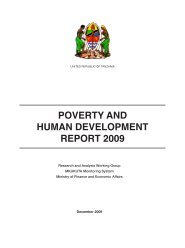Download PDF (4.08 MB) - ReliefWeb
Download PDF (4.08 MB) - ReliefWeb
Download PDF (4.08 MB) - ReliefWeb
You also want an ePaper? Increase the reach of your titles
YUMPU automatically turns print PDFs into web optimized ePapers that Google loves.
56<br />
References and suggested further reading<br />
1. UNDP. Guidance for Community Infrastructure<br />
Sector. PDNA Annex: 7 Template. May 2009.<br />
2. UNDP Nepal. Quick Impact and Peace Support<br />
Initiative First Phase (QIPSI-I) Completion Report.<br />
November 2008.<br />
3. UNEP. Background Paper on Green Jobs. 2008,<br />
p.7.<br />
B and C interventions) are also important. Accordingly, the exit strategy should articulate<br />
how the project is expected to contribute to progress toward the goals of national recovery<br />
and development strategies and plans.<br />
3.3.3 Addressing crosscutting priorities<br />
Like all livelihoods and economic recovery projects, those involving infrastructure rehabilitation<br />
can successfully promote gender equity and women’s empowerment, reduce<br />
conflict and disaster risk, strengthen market activity, and avoid causing harm in any of<br />
these areas only if they are designed carefully with these objectives in mind. This section<br />
provides points to consider for addressing these crosscutting priorities in programming<br />
for infrastructure rehabilitation.<br />
Gender sensitivity. Gender-sensitive work on infrastructure rehabilitation promotes gender<br />
equality and women’s economic and social empowerment. It is gender-responsive<br />
in both design and process. The needs, concerns, and priorities of both women and<br />
men are taken into account in designing the project. Women are consistently part of the<br />
decision-making process and hold leadership positions in the organizations that carry<br />
out the rehabilitation work. In this way, the infrastructure rehabilitation process can set<br />
precedents for expanding women’s roles and influence in the public domain. Rehabilitation<br />
efforts also offer important opportunities for providing short-term employment for<br />
women and girls. The key points on gender sensitivity in emergency employment projects<br />
(see section 3.1.3 above) are also relevant to employment for infrastructure rehabilitation.<br />
Conflict and disaster-risk sensitivity. For infrastructure rehabilitation to promote social<br />
cohesion and reduce vulnerability, the process must be conflict and disaster-risk sensitive.<br />
The new infrastructure—and the rehabilitation process itself—should create space for more<br />
frequent and constructive interaction within the community. Any potential for exacerbating<br />
social tensions should be identified and mitigated prior to project implementation.<br />
Disaster risk reduction and conflict prevention expertise may be required to ensure that<br />
the resulting infrastructure is disaster-resilient and that local conflict management systems<br />
are set up and strengthened to avoid conflicts stemming from the rebuilding process.<br />
Market sensitivity. The project design should take into account all available information<br />
about the local market. Information on the market for goods and services will help to<br />
identify and prioritize the infrastructure rehabilitation schemes that are most important<br />
in terms of for reviving market activity. Information on the labour market will help to<br />
determine the availability of labour for infrastructure rehabilitation work and the appropriate<br />
wage rates for skilled and unskilled workers. Information on the local market<br />
for the inputs the project will procure (equipment, tools, construction materials, project,<br />
supplies, etc.) is essential for a smooth procurement process and for avoiding any market<br />
distortions that the project may create. Ongoing monitoring of market conditions is<br />
necessary throughout implementation in order to ensure that the project has a positive<br />
impact on local economic recovery.<br />
For additional information, please see discussion papers in Annex:<br />
9. Infrastructure Rehabilitation.<br />
10. New Approaches to Livelihoods Stabilization: from Emergency Employment to Long Term<br />
Employment<br />
12. Community Contracting<br />
Livelihoods & Economic Recovery in Crisis Situations





